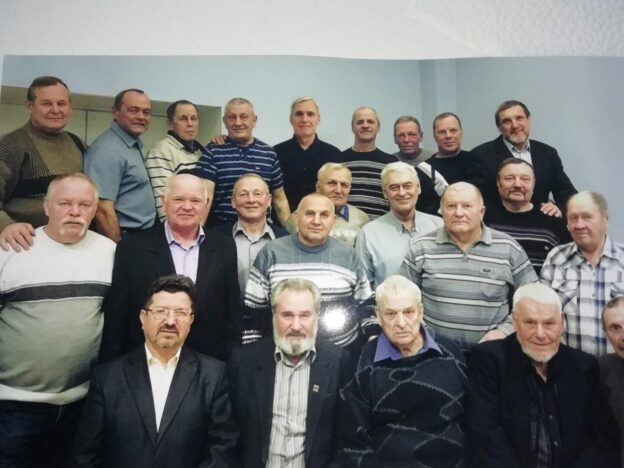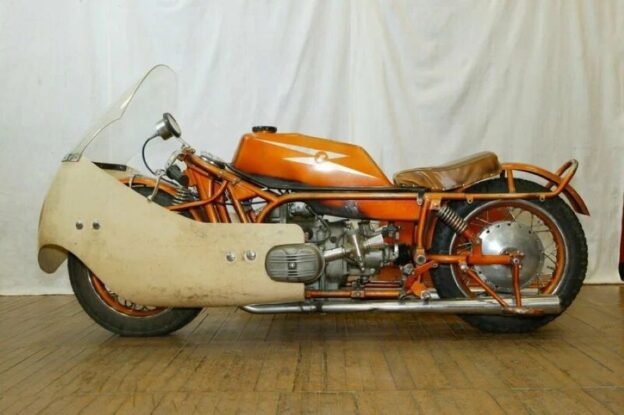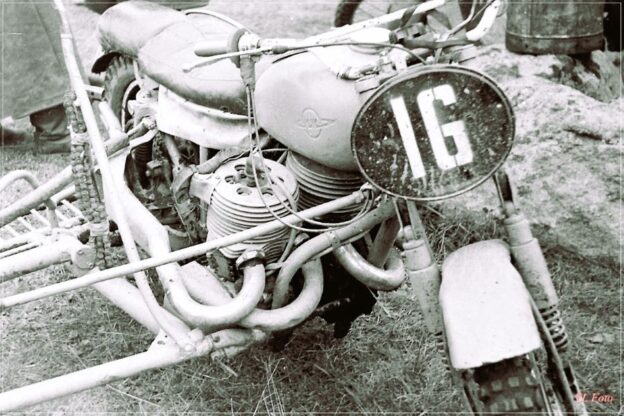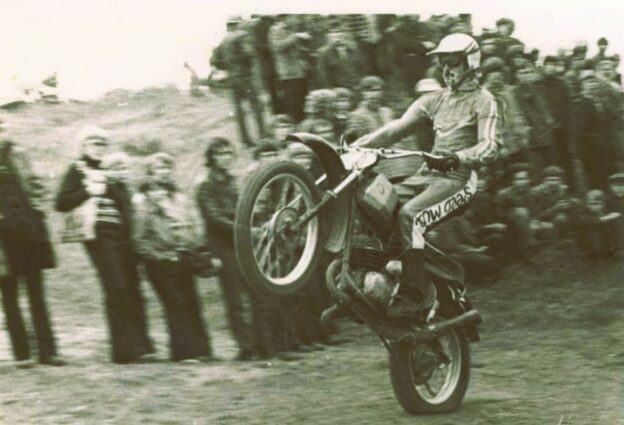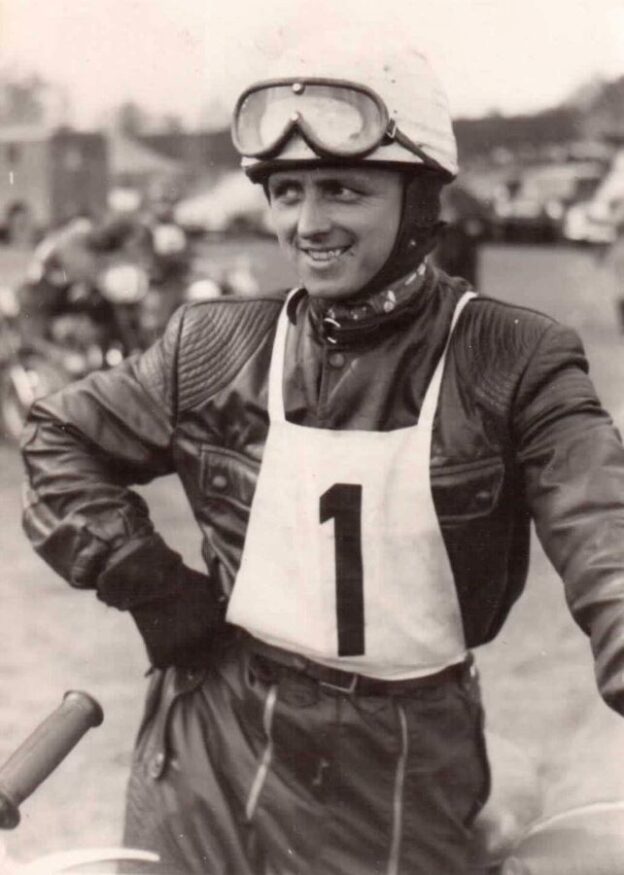photo above: Andrey Valentinovich Spitsyn aboard a Serpukhov dream concept
Surpukhov origins
The history of motorcycle sports in Serpukhov began in the 1930s. According to the memoirs of a member of the Executive Committee of the National Russian Motorcycle Federation Vladimir Nikolaevich Potapov, published in a number of journals, accounts of the first motorcycle race in Serpukhov – linear, with a distance of one kilometer – took place in the summer of 1936. The event was judged by the famous Soviet pilot Valery Chkalov. The start of the race was in Novye Kuzmenki, and finished in Volosovo.
In 1939, the town of Serpukhov became one of the main centers for the development and production of domestic motorcycles in the USSR. Here from Podolsk transferred the production of a light motorcycle brand ML-3 with a 125-cc two-stroke engine. This was one of the first two-wheeled vehicles in the Soviet Union, created for personal use.
In 1942, the Leading Design Bureau (VKB) began its work in Serpukhov. Its employees, under the leadership of Vsevolod Vyacheslavovich Rogozhin – a famous designer, creator of the IZH-7 motorcycle – were engaged in the study and repair of captured German motorcycles, the assembly of American Harley-Davidson and Indian, supplied under Lend-Lease, as well as the refinement of motorcycles of the burgeoning Soviet motorcycle industry.
in 1946, the VKB was reorganized into the Central Design and Experimental Bureau. Here they were closely engaged in the development of purely domestic motorcycles. Types of promising equipment appeared, new designs were designed, and testing carried out. The Surpukhov motorcycle factory produced both experimental samples and small batches of serial motorcycles for evaluation.
The design bureau grew into the All-Russian Research Institute – VNIIMOTOPROM – in 1965, and Serpukhov became one of the leading centers in the country for the development and production of motorcycles. Unfortunately, the economic storms of the recent decades did not spare the unique scientific and production potential of the Institute. in 2011, VNIIMotoprom ceased to exist. But the memory of it has been preserved not only in the memories of his employees, but also in the successfully functioning racetrack on the territory of the Krasnye Krylia complex in the village of Vasilyevskoye.
Started in 1942
Simultaneously with the creation of the VKB in Serpukhov, motorcycle racing began to develop by the bureau’s employees and enthusiasts. Early competitions took place in 1942. Everyone who had a motorcycle at that time participated in the races. The competition was judged by Vsevolod Rogozhin, director of the Serpukhov VKB, judge of the all-Union category (later – chairman of the Motorsport Federation of the Soviet Union). In the mid-1950s in Serpukhov there was already a powerful motorcycle club, in which champions were raised.
One of the first Serpukhov riders who went down in the history of motorsport was Stanislav Kudinov. At the age of 13, he came to work at the VKB as a fitter-assembler of trophy machines. Stanislav independently prepared a four-stroke overhead valve motorcycle NSU-250 and won on it in 1944 a cross country for the championship of armored forces. In 1947, Stanislav, who was only 18 years old, became the champion of the USSR. Subsequently, Stanislav Kudinov together with Yuri Ignatevich Trofimts led the national team. In those years, the team held the world championship.
The beginning of the now very popular races on ice was also laid in Serpukhov. One of the founders of these races was an employee of the Plant “Metalist” Vladimir Zemlyanov. The ice was frozen at the Spartak Stadium. Then there and at the stadium “Trud” winter motorcycle competitions were held.
In 1972, a new sports department was created at VNIIMotoprom, whose work was entirely devoted to the development of motorsport in Russia. Unique racing motorcycles were developed here, which were in no way inferior for that time to foreign analogues.
The race track was located on Novotkatska Street in Serpukhov. It existed until 1984. Then, on the instructions “from above”, it was closed. And in 1989, a site was allocated and equipped near the village of Vasilyevskoye, now known as the Krasnye Krylya highway.
Back to the Future
Andrey Valentinovich Spitsyn is a man who, without exaggeration, is known to all motorsport fans in Russia, and even abroad, beyond the bounds in foreign countries. He has been commenting on competitions of various ranks for almost thirty years. And he, being an employee of VNIIMotoprom, stood at the origins of the track in Vasilyevsky. Here are his memories of the first competitions that took place immediately after the opening of the track:
“Digging through the wastepaper, I found the results of motocrosses since 1989, which were held on the former track of VNIIMotoprom. Until 1985, motocross was held on the outskirts of Serpukhov (Novotkatska district), but due to the “numerous” requests of the residents, this route was suspended and closed. The new director of VNIIMotoprom, Oleg Ivanovich Sokolov, decided to obtain a new venue, and it was possible to find new land in the district. The opening of the new track was timed to coincide with the 650th anniversary of Serpukhov in 1989, it was quite stormy. The weather, however, was not important: rain and mud. Initially, the track resembled enduro (a special kind of motorcycle racing, editor’s note). Riders would come out of workshops and out of the woods. Gradually, parts of the forest was cut down, and the track became more spectacular. The starting grid was of its own design also turned out to be unsuccessful. Firstly, it was too narrow, and secondly – a long two meters of bare concrete! Sidecars at the start almost destroyed the rear tire. In 1989, Vladimir Karneev commented, and I was pulled up to this case a year later in 1990. Vladimir Ivanovich Karneev visited us a couple of times, the last year in 1996-97. After 1997 there was a break until 1999 and the last time Motoprom held a cross was in 2002. And who was Rogozhin? It is possible not to know who VNIIMotoprom is, but it is difficult not to know Rogozhin. After the war, we had Izh-49, “Kaka-Makaka” (so called motorcycles produced by Kovrov and Moscow motor plants, editor’s note), Moskvich-400 (401), etc. The export of all this good from defeated Germany was commanded by a red major, who later preferred not to go to the GDR on this occasion, it was he …”
The track in Vasilyevsky today consists of three parts: supercross – 800 m, classic motocross – 1700 m and enduro track – 5 km. Almost 8 kilometers of difficult ascents, descents, turns and jumps. Unfortunately, the professional team that trained here broke up in 2007. But already in 2008, a children’s motorsport school was opened, headed by Dmitry Sergeevich Semenkov. On the eve of the anniversary of the track, we talked to him about what the school is doing now.
– We have about forty children of different ages. Two groups – beginners and training, and another group of higher sports skills of 5 people. We also have very young pupils – six-year-olds. But they, of course, do not sit on “adult” motorcycles, they have their own equipment – small bicycles and mini-motorcycles. We introduce them to the technical complex environment, give them the opportunity to try themselves on simulators, – says Dmitry Semenkov. – We train in any weather. When it is clear – on the street. In the rain or snow – in the hall, on simulators. We actively take part in various competitions and successfully take prizes. We have a free school, but, quite naturally, parents help, there are sponsors.
Sport is not the cheapest: you need special equipment, constant care for motorcycles, and for the track. The former Head of the city district administration Dmitry Zharikov saw in us a good perspective. The history of Serpukhov is rich in champions in motorsport, and we want to preserve these traditions. So we hope for the support of the new Head – Yulia Olegovna Kupetskaya. For boys and girls who study with us, this is very important. Upon the arrival of the team from the final of the Russian Championship, which takes place in Kovrov and Krasny-on-Volga, we will prepare for competitions dedicated to the anniversary of the track in Vasilyevsky. We are waiting for everyone who wants to cheer for our athletes!
Motorsport in Serpukhov is not only alive, but also actively developing thanks to enthusiasts. In May of 2022, after a long break, starts for the Cup of the Head of the City were held. The track in Vasilyevsky is not idle, “nurturing” future champions. Spectacular competitions are held here, gathering a large number of spectators not only from Serpukhov, but also from other regions. And it is believed that young Serpukhovichi, who connected their sports life with a motorcycle, worthily replace outstanding, in the full sense of the word, motorcycle racers, such as Alexander Orlov, Alexei Melnikov, Yuri Matveev, Pyotr Kvasov, Gennady Ivanov, Konstantin Matyushin, the Kiryukhin and Sedov brothers, who glorified the Soviet Union and Russia. We can say that the future of motorsport is in its glorious past, and reaching to the future.
from the personal archives of A. V. Spitsyn and D. S. Semenkov
source: MKRU Serpukhov Sport

